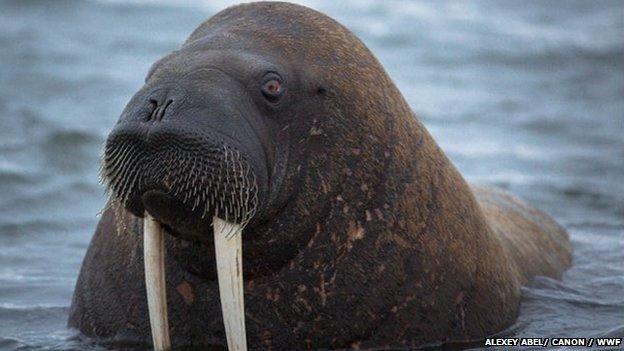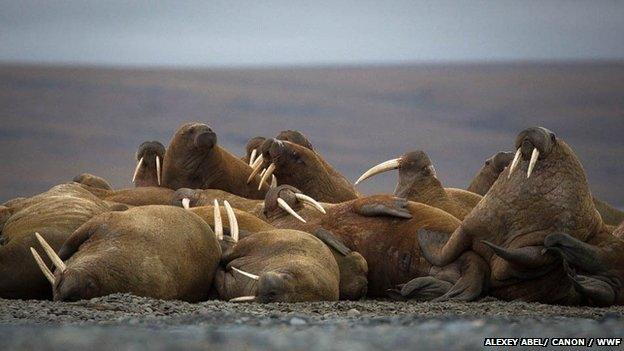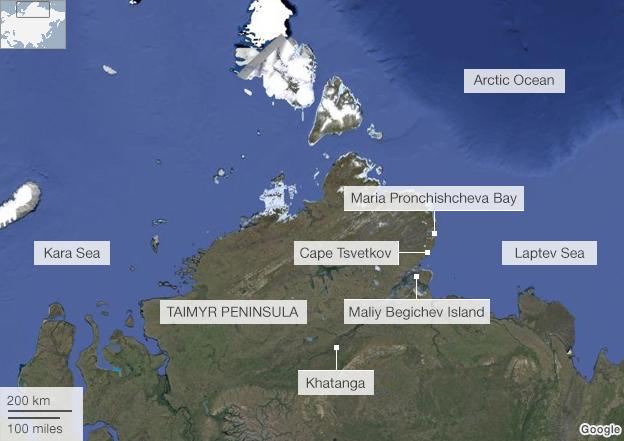Russia's Arctic: Laptev walrus
- Published

A Laptev walrus on the Taimyr Peninsula, in Russia's far north
On an expedition to the far north of Russia to conduct an ecological survey, the BBC's Daniel Sandford reports on how scientists fear the local walrus population may be at risk.
There are two known sub-species of walrus - the Atlantic walrus and Pacific walrus, though scientists are trying to confirm if there is in fact a third sub-species unique to Russia's Laptev Sea. Whether or not the sub-species exists has been a debate among walrus experts for many years. One of the aims of the WWF's 2013 Laptev Expedition is to resolve this question using DNA analysis.
Almost all walruses live inside the Arctic Circle or in seas close by. They feed on mussels and clams, which they suck off the bottom of the sea.
Walruses do not feed much more than 100m (328ft) under the sea, so as the Arctic sea ice retreats into more northerly, deeper waters (the Arctic Ocean is 4,500m deep at the North Pole) the walruses are having to come ashore in the summer in huge numbers.
In Cape Sertsekamen in Russia, an estimated 115,000 come ashore in the autumn - that is almost all the Pacific walrus that there are in the world.
There are concerns that such huge concentrations of walrus could wipe out the mussel and clam populations in some areas. Conservationists also worry that if there were an oil spill close to such a massive Pacific walrus "haul-out", then an entire sub-species would be at risk.
"The areas that have been earmarked for oil and gas exploration around Chukotka in the Russian Arctic are exactly the same places where mothers go with young calves. Drilling there will have unknown consequences," explained Anatoly Kochnev of Chukottinro, the Chukotka branch of Russia's Pacific Research Fishery Centre.
"When the drilling starts we need to have constant monitoring to check what the impact is."
Reserves unprotected
He also said that nobody knows what effect the increase in shipping through the Arctic will have on the walruses. It is not even known exactly where their feeding grounds are.

Walruses are coming ashore in greater numbers as the ice retreats further north
Walrus calves stay with their mothers for up to three years - an unusually long time for seals. When there was permanent sea ice in large parts of the Arctic, the mother would leave the calves on the ice, where they were relatively safe. But now that so many walruses are having to come ashore, far from the feeding areas, the calves are having to swim exhausting, long distances with their mothers while they dive for food.
Walruses can actually sleep while at sea. They fill their larynxes with air and these act like lifejackets around their neck , keeping their head afloat as they snooze.
When walruses come ashore in mass haul-outs they are easily panicked, and can crush each other to death as they rush into the sea. At one point a haul-out on Russia's Wrangel Island ended up under an aircraft flight path, and lots of walruses were killed in the panic.
Russia has no specific plan to protect the walrus - only wildlife reserves that have been created along parts of the coast - but the walruses do not stay in those reserves.
"It is very important to protect walruses when they are ashore, but that is only part of the protection they need," Anatoly Kochnev said.
"Anyway," he added, "the reserves - like the one on the Laptev Sea - are not properly policed."
